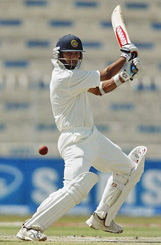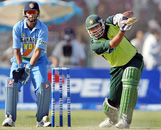COACHING
The Art of Batting - III
- By Polly Umrigar In the Late cut, the right foot should be moved outside the off stump and the weight of the body transferred onto it.It is unsafe to try this stroke against fast bowlers and off spinners, but against medium pace or leg-break bowlers, there is a good chance of reward.
In this shot, the wrist plays an important part, but the ball's own momentum is the chief source of speed. The stroke is a short and snappy one and does not have a long swing of the bat.
[ J ] THE SQUARE CUT
There are two square cuts - one played off the front foot and the other off the back foot. In both these strokes the ball must be short and wide of the off stick.
Rahul Dravid essays the back-foot square-cut
Square cut off the front foot:-
The left leg should be advanced forward and across the wicket, so that it finishes with the toe directed towards cover and the left leg carrying the full weight. To make this shot, the ball should be short-pitched and away from the off-stump. The shoulder at the start of the swing should be pointing towards mid-off so that the maximum power can be put into the swing. The shoulders turn only with the impetus of the hit, which should be made with full force of the right hand, forearm and shoulders. The ball should be hit down and not cut into the air. The ball should go just backward of cover.
Square cut off the back foot:-
This shot is more in play than the one off the front foot as it gives more time to the batsman to see the ball. This time, it is the right foot that is thrown across and the weight is transferred to the right leg. The knee should be flexed to slightly assist -
The left leg should be advanced forward and across the wicket, so that it finishes with the toe directed towards cover and the left leg carrying the full weight. To make this shot, the ball should be short-pitched and away from the off-stump. The shoulder at the start of the swing should be pointing towards mid-off so that the maximum power can be put into the swing. The shoulders turn only with the impetus of the hit, which should be made with full force of the right hand, forearm and shoulders. The ball should be hit down and not cut into the air. The ball should go just backward of cover.
Square cut off the back foot:-
This shot is more in play than the one off the front foot as it gives more time to the batsman to see the ball. This time, it is the right foot that is thrown across and the weight is transferred to the right leg. The knee should be flexed to slightly assist -
Playing this stroke to off-spinner can be extremely dangerous if the ball is turning.
[ K ] FORWARD DRIVES
- Cover drive
- Off drive
- Straight drive
- On drive
- Lofted drive
A batsman will normally attempt to drive a ball that is slightly over-pitched so that he may not loft the ball. The left shoulder must lean forward. The left hip too must go well forward as the weight is transferred onto the front foot. The distance a batsman needs to advance his left foot down the pitch depends on the length of the ball and the type of bowler.

Inzamam-ul-Haq
plays the cover drive
For the cover drive, the left toe
should point towards cover and then it would progressively point a little more
directly towards the bowler for the other drives, round to mid-on. For
instance, it should point towards mid-off for the off-drive, towards the bowler
for the straight drive, and towards mid-on for the on-drive.
The left leg must carry the weight of the body at the moment of contact, but it should be comfortably bent at the knees to maintain balance. In all cases, the right heel should be lifted and the right leg balanced on the toe, which is kept clearly behind the popping crease.
The left leg must carry the weight of the body at the moment of contact, but it should be comfortably bent at the knees to maintain balance. In all cases, the right heel should be lifted and the right leg balanced on the toe, which is kept clearly behind the popping crease.
The ball must be struck just before the bat becomes perpendicular to the ground in order to keep it on the ground. The lofted drive is used to either upset a spin bowler or when one has to go for the runs. However, this shot should be used with discretion.
[ I ] JUMPING OUT TO DRIVE
When a slow bowler is operating and is giving the ball a reasonable amount of air by tossing it up, he is naturally doing this to try to get more turn on the ball. The batsman's job is to counter this idea and one of the best ways in which to do this is to use the feet and go down the wicket to attack the bowling, either hitting it on the half volley or full toss to prevent the spin from taking effect.